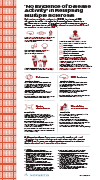Novartis real-world data at AAN confirms benefit of Gilenya® on four key measures of disease activity in relapsing MS
- Over 16 months, more than 75% of patients on Gilenya had either no relapses, no new or enlarged MRI lesions or no disability progression; around 58% showed brain shrinkage levels broadly within the range expected for people without MS
- Approximately 60% of patients achieved NEDA-3 (no relapses, no MRI lesions and no disability progression combined) and 38% achieved NEDA-4 (NEDA-3 plus no brain shrinkage), further supporting findings from clinical trials
- First real-world multicenter study showing that monitoring brain shrinkage using routine imaging methods is reliable and could be adopted in daily clinical practice
Basel, April 24, 2017 – Novartis today announced data from the Phase IV Multiple Sclerosis and clinical outcome and MRI in the US (MS-MRIUS) study, which confirmed the effectiveness of Gilenya® (fingolimod) in the real-world setting, supporting previous findings from Phase III trials1,2. Results show that Gilenya impacted four key measures of MS disease activity (relapses, MRI lesions, disability progression and brain shrinkage), in people with relapsing-remitting multiple sclerosis (RRMS) for up to 16 months1. This is also the first time a multicenter study has evaluated and shown that routine magnetic resonance imaging (MRI) scans taken in the every-day clinical setting can reliably be used to measure brain shrinkage, a key measure of disease progression, in people with RRMS3. Full results are presented at the 69th American Academy of Neurology (AAN) Annual Meeting, in Boston, Massachusetts, USA.
The MS-MRIUS study is a multicenter (33 centers), retrospective, real-world study of 590 people with RRMS receiving Gilenya treatment1. At median follow-up of 16 months, 85.8% of individuals treated with Gilenya remained on treatment1. Of individuals eligible for NEDA-3 assessment (no relapses, no new or enlarged MRI lesions and no disability progression combined, n=586), 59.6% achieved NEDA-3 status1. Of those eligible for NEDA-4 assessment (NEDA-3 plus no brain shrinkage (brain volume loss), n= 325), more than a third (37.5%) achieved NEDA-4 status1. The study showed that among the NEDA-4 patients, 86.5% treated with Gilenya had no relapses, 91.1% experienced no disability progression and 79.7% had no new or enlarged MRI lesions1. In addition, 58.2% of patients had no MS-related brain shrinkage over 0.4%, which is broadly within the range one would expect to see in people without MS1.
“These data build on the wealth of clinical and real-world evidence that show Gilenya is a highly efficacious, long-term treatment option for controlling disease activity in relapsing MS,” said Vas Narasimhan, Global Head of Drug Development and Chief Medical Officer, Novartis. “Measuring brain shrinkage has historically been dependent on specialist brain scanning techniques. These ground-breaking new data showing brain shrinkage can be reliably measured by routine MRI scans have the potential to change how this key measure of disease progression is monitored, to ultimately help patients and physicians observe and manage treatment success and outcomes.”
The data showed for the first time that MRI scans with techniques readily available in clinical practice (FLAIR – fluid attenuation inversion recovery MRI), was a reliable method for measuring brain shrinkage in more than 95% of people included in the study3.
Results from the MS-MRIUS study confirm the importance of addressing the four key measures of MS disease activity – relapses, MRI lesions, disability progression and brain shrinkage – through early and effective treatment to impact the course of RRMS and preserve patients’ physical and cognitive function over the long-term.
About the MS-MRIUS study
The Multiple Sclerosis and clinical outcome and MRI in the US (MS-MRIUS) study is a Phase IV multicenter (33 sites), retrospective study including 590 people with relapsing-remitting multiple sclerosis (RRMS)1. The study investigated the effect of Gilenya on achieving ‘no evidence of disease activity’ (NEDA), magnetic resonance imaging (MRI) efficacy measures among people with RRMS, and also the feasibility of measuring brain shrinkage in routine clinical practice1-3. 586 patients were eligible for NEDA-3 and 325 patients were eligible for NEDA-4 evaluation, based on the availability of high resolution scans1.
Individuals were required to undergo MRI scans within six months before, or one month after, the start of Gilenya treatment, followed by another MRI scan between nine and 24 months after the start of treatment1.
Evaluation of NEDA was based on measurement of annualized relapse rate, MRI lesions and disability progression, as measured by the mean Expanded Disability Status Scale (EDSS) score, (NEDA-3) and MS-related brain shrinkage (NEDA-4), measured using whole brain volume loss (no MS-related brain shrinkage >0.4%)1.
To assess the feasibility of measuring brain shrinkage in routine clinical practice, changes in lateral ventricle volume (LVV) were evaluated using fluid attenuation inversion recovery (FLAIR) MRI scans. LVV could be used as a proxy for whole brain volume changes, measured in high resolution MRI scans3.
About Gilenya® (fingolimod)
Gilenya is an oral disease-modifying therapy (DMT) that is highly efficacious at controlling disease activity in relapsing MS (RMS)4. Gilenya has a reversible lymphocyte redistribution effect targeting both focal and diffuse central nervous system (CNS) damage caused by MS5,6. Long-term clinical trial and real-world evidence and experience has shown Gilenya treatment to be convenient for individuals to incorporate into everyday life, leading to high treatment satisfaction, long-term persistence, and ultimately, improved long-term outcomes for people with RMS7,8.
Gilenya impacts four key measures of RMS disease activity: relapses, MRI lesions, brain shrinkage (brain volume loss) and disability progression9,10. Its effectiveness on all of these measures has been consistently shown in multiple controlled clinical studies and in the real-world setting. Studies have shown its safety and high efficacy to be sustained over the long term, demonstrating that switching to Gilenya treatment as early in the disease course as possible can be beneficial in helping to preserve individuals’ function11,12.
Gilenya is approved in the US for the first-line treatment of relapsing forms of MS in adults and in the EU for adult patients with highly-active relapsing-remitting MS (RRMS) defined as either high disease activity despite treatment with at least one DMT, or rapidly-evolving severe RRMS4,13.
Gilenya has been used to treat more than 204,000 patients in both clinical trials and the post-marketing setting, with approximately 424,000 years of patient experience14.
About Multiple Sclerosis
Multiple sclerosis (MS) is a chronic disorder of the central nervous system (CNS) that disrupts the normal functioning of the brain, optic nerves and spinal cord through inflammation and tissue loss15. There are three types of MS: relapsing-remitting MS (RRMS), secondary progressive MS (SPMS) and primary progressive MS (PPMS)16. The evolution of MS results in an increasing loss of both physical and cognitive (e.g. memory) function. This has a substantial negative impact on the lives of the approximately 2.3 million people worldwide affected by MS17.
About Novartis in Multiple Sclerosis
The Novartis multiple sclerosis (MS) portfolio includes Gilenya (fingolimod, an S1P modulator), which is indicated for relapsing forms of MS and is also in development for pediatric MS. Extavia® (interferon beta-1b for subcutaneous injection) is approved in the US for the treatment of relapsing forms of MS. In Europe, Extavia is approved to treat people with relapsing-remitting MS, secondary progressive MS (SPMS) with active disease and people who have had a single clinical event suggestive of MS.
Investigational compounds include BAF312 (siponimod), under investigation in MS, and OMB157 (ofatumumab), a fully human monoclonal antibody in development for relapsing MS. Ofatumumab targets CD20, and is currently being investigated in two Phase III pivotal studies.
In the US, the Sandoz Division of Novartis markets Glatopa® (glatiramer acetate injection) 20mg/mL, the first generic version of Teva's Copaxone®* 20mg.
*Copaxone® is a registered trademark of Teva Pharmaceutical Industries Ltd.
Disclaimer
The foregoing release contains forward-looking statements that can be identified by words such as “could,” “build on,” “can,” “potential,” “in development,” “investigational,” “under investigation,” “being investigated,” or similar terms, or by express or implied discussions regarding potential new indications or labeling for Gilenya or Extavia, potential marketing approvals for BAF312 and OMB157, or regarding potential future revenues from Gilenya, Extavia, Glatopa, BAF312 and OMB157. You should not place undue reliance on these statements. Such forward-looking statements are based on the current beliefs and expectations of management regarding future events, and are subject to significant known and unknown risks and uncertainties. Should one or more of these risks or uncertainties materialize, or should underlying assumptions prove incorrect, actual results may vary materially from those set forth in the forward-looking statements. There can be no guarantee that Gilenya or Extavia will be submitted or approved for any additional indications or labeling in any market, or at any particular time. Neither can there be any guarantee that BAF312 or OMB157 will be approved for sale in any market, or at any particular time. Nor can there be any guarantee that any of Gilenya, Extavia, Glatopa, BAF312 or OMB157 will be commercially successful in the future. In particular, management’s expectations regarding such products and investigational compounds could be affected by, among other things, the uncertainties inherent in research and development, including clinical trial results and additional analysis of existing clinical data; regulatory actions or delays or government regulation generally; the company’s ability to obtain or maintain proprietary intellectual property protection; general economic and industry conditions; global trends toward health care cost containment, including ongoing pricing and reimbursement pressures; safety, quality or manufacturing issues, and other risks and factors referred to in Novartis AG’s current Form 20-F on file with the US Securities and Exchange Commission. Novartis is providing the information in this press release as of this date and does not undertake any obligation to update any forward-looking statements contained in this press release as a result of new information, future events or otherwise.

